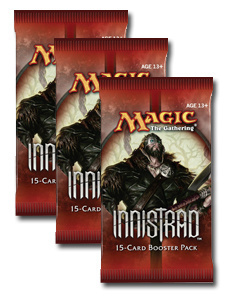Are you a Quiet Speculation member?
If not, now is a perfect time to join up! Our powerful tools, breaking-news analysis, and exclusive Discord channel will make sure you stay up to date and ahead of the curve.
Seriously, there is so much good to be read here. On the blog Killing a Goldfish, a retrospective review of Innistrad block was recently published. It is good. It is very good. You should go read the whole thing. If you're more of a tl;dr type, I'll quote my favorite sections below. But you should skip that and just read it, because wow.
Innistrad isn’t just a well-designed limited format. It is the best limited format. The set is so tightly designed that I’d rather play six-pack Innistrad sealed than draft almost any other set. And when you actually draft it… holy god, there’s nothing better. I can’t do my usual “well this is good, and this was bad” shtick, because nothing in it was bad.
...
But it’s not just that these decks [Burning Vengeance and Spider Spawning] exist that make Innistrad the best limited format ever. It’s how it took legitimate work in order for them to be found out; players had to sift through dozens of other proposed archetypes to find them. Timelines differ on how long it took people to catch onto Spider Spawning (especially the “infinite” version), but it was certainly over a month of professionals drafting the format multiple times a day, every day, before anyone found out about it. That’s the definition of an archetype buried in a set, and I doubt that sort of uncovering can ever happen again.
...
At the opposite end of the spectrum lay Innistrad’s unplayable cards. Rosewaterist design philosophy tells us that cards at the end of the pack, the cards that are completely worthless even in limited, are a necessary evil of a large set. Without them, the thinking goes, their place would simply be taken up by the next-worst cards in the set. It is therefore impossible to be rid of unplayable cards.Innistrad demonstrates that this is wrong. I encourage you, reader, to go through the entire set of Innistrad and find me cards that are completely limited-unplayable, in every archetype, even out of the sideboard. If you find more than three, you’re just evaluating some of them incorrectly....I, personally, bought 54 packs of Avacyn Restored (including event entry, but excluding all prize packs). This is potentially the most physical packs I’ve ever purchased of a single set; it’s certainly the only set I’ve ever bought a box of (let alone preordered). 48 of these packs were purchased on or before the day of release.So when Mark Rosewater goes into his yearly design column about things that were good and bad in the previous year, and he tells me, a paying customer of his company’s product, that he knows that Avacyn Restored must be a good set because people (such as myself) bought so many packs of it… that is offensive.I’m often accused of being angry about Magic-related things (namely in these reviews), when that is rather rarely the case. I am often contemplative, usually taking things into historical consideration rather than blindly loving things, a skeptic in a room full of blind optimists. But I am actually angered by Rosewater scoreboard-pointing over Avacyn Restored, and I hope my readers excuse the vitriol to come.The reason I bought 54 packs of Avacyn Restored is that Wizards fucking betrayed me. After my favorite limited format ever, I was willing to throw down an amount of money (far more than the average player spends on packs) completely blind, based on a trust that the company had built up with me based on their previous sets. And that trust was completely shattered....Executive summary: on average, Innistrad block was average.





